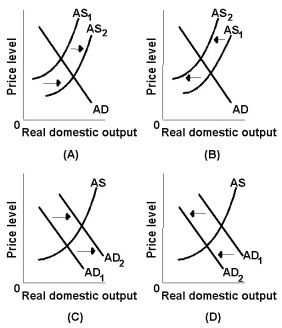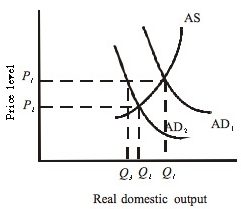 |
| 1 |  | 
In macroeconomics, the long run is characterized by: |
|  | A) | a horizontal aggregate supply curve. |
|  | B) | a vertical aggregate demand curve. |
|  | C) | a period in which nominal wages have fully responded to changes in the price level. |
|  | D) | a period in which nominal wages are fixed. |
|
|
 |
| 2 |  | 
Which of the following is a correct statement? All else equal: |
|  | A) | a decrease in the real rate of interest will reduce the level of investment. |
|  | B) | a decrease in the real rate of interest will increase the level of investment. |
|  | C) | an increase in business taxes will increase the level of investment. |
|  | D) | an increase in the level of current disposable income will decrease the level of investment. |
|
|
 |
| 3 |  | 
If aggregate demand and aggregate supply both decrease: |
|  | A) | real GDP and the price level will both fall. |
|  | B) | real GDP will fall and the price level will decrease. |
|  | C) | the price level will fall but real GDP may either increase or decrease. |
|  | D) | real GDP will fall but the price level may or may not increase. |
|
|
 |
| 4 |  | 
Answer the question using the following diagrams. <a onClick="window.open('/olcweb/cgi/pluginpop.cgi?it=jpg::::/sites/dl/free/0073511455/991476/ch12_q4.jpg','popWin', 'width=NaN,height=NaN,resizable,scrollbars');" href="#"><img valign="absmiddle" height="16" width="16" border="0" src="/olcweb/styles/shared/linkicons/image.gif"> (40.0K)</a> <a onClick="window.open('/olcweb/cgi/pluginpop.cgi?it=jpg::::/sites/dl/free/0073511455/991476/ch12_q4.jpg','popWin', 'width=NaN,height=NaN,resizable,scrollbars');" href="#"><img valign="absmiddle" height="16" width="16" border="0" src="/olcweb/styles/shared/linkicons/image.gif"> (40.0K)</a>
Which of the above diagrams best portrays the effects of a significant decrease in energy prices? |
|  | A) | A |
|  | B) | B |
|  | C) | C |
|  | D) | D |
|
|
 |
| 5 |  | 
If real output increases and the price level remains stable, it is likely that: |
|  | A) | both aggregate demand and aggregate supply have decreased. |
|  | B) | aggregate demand has increased and aggregate supply has decreased. |
|  | C) | aggregate demand has decreased and aggregate supply has increased. |
|  | D) | both aggregate demand and aggregate supply have increased. |
|
|
 |
| 6 |  | 
Answer the question using the following graph: <a onClick="window.open('/olcweb/cgi/pluginpop.cgi?it=jpg::::/sites/dl/free/0073511455/991476/ch12_q6.jpg','popWin', 'width=NaN,height=NaN,resizable,scrollbars');" href="#"><img valign="absmiddle" height="16" width="16" border="0" src="/olcweb/styles/shared/linkicons/image.gif"> (22.0K)</a> <a onClick="window.open('/olcweb/cgi/pluginpop.cgi?it=jpg::::/sites/dl/free/0073511455/991476/ch12_q6.jpg','popWin', 'width=NaN,height=NaN,resizable,scrollbars');" href="#"><img valign="absmiddle" height="16" width="16" border="0" src="/olcweb/styles/shared/linkicons/image.gif"> (22.0K)</a>
Refer to the graph. Suppose aggregate demand falls from AD1 to AD2. Initially, this will cause output to: |
|  | A) | fall to Q2 and the price level to P2. |
|  | B) | fall to Q2, but the price level to remain at P1. |
|  | C) | fall to Q3, but the price level to remain at P1. |
|  | D) | remain unchanged, but the price level will fall to P2. |
|
|
 |
| 7 |  | 
All else equal, depreciation of the dollar will shift: |
|  | A) | both aggregate demand and aggregate supply to the left. |
|  | B) | both aggregate demand and aggregate supply to the right. |
|  | C) | aggregate demand to the left and aggregate supply to the right. |
|  | D) | aggregate demand to the right and aggregate supply to the left. |
|
|
 |
| 8 |  | 
If an adverse supply shock initiates an episode of cost-push inflation and the government does nothing in response, there will likely be: |
|  | A) | an increase in real GDP in the short run but not the long run. |
|  | B) | an inflationary spiral. |
|  | C) | a recession. |
|  | D) | a decrease in aggregate demand. |
|
|
 |
| 9 |  | 
Demand-pull inflation is associated with: |
|  | A) | a movement upward and to the left along the aggregate demand curve. |
|  | B) | a leftward shift of the aggregate supply curve. |
|  | C) | a leftward shift of the aggregate demand curve. |
|  | D) | a rightward shift of the aggregate demand curve. |
|
|
 |
| 10 |  | 
The short-run aggregate supply curve: |
|  | A) | assumes that wages and salaries fully match any change in the price level. |
|  | B) | is vertical at the full-employment level of output. |
|  | C) | shows the amount of real output supplied at various price levels. |
|  | D) | becomes increasingly flatter as output expands. |
|
|

